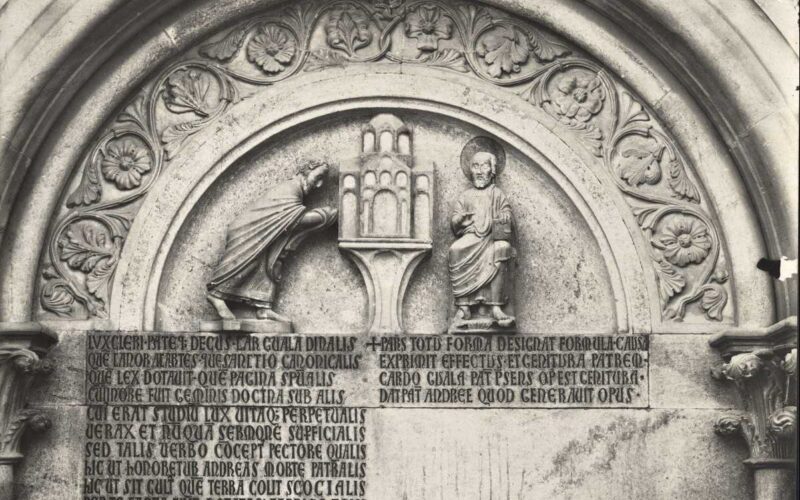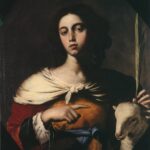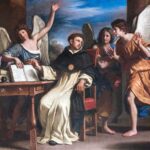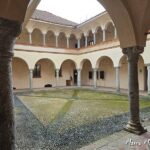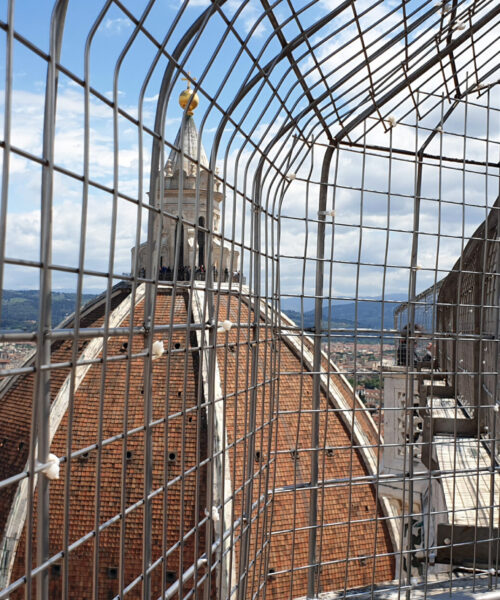The lunette in the left portal of the Sant’Andrea Basilica in Vercelli, a exquisite example of the Antelami school, visually narrates the story of Cardinal Guala Bicchieri’s donation. In a gesture of profound devotion, he donated the church to Saint Andrew, an event immortalized in stone on February 19, 1219.
The lunette’s architrave is adorned with a long Latin inscription, a veritable sculpted poem praising Cardinal Bicchieri:
“Lux cleri patriaeque decus car, Guala Bircalis, Quem canor atque arles , quem sanclio cauonialis, Qua/n lex dotavit, quezn pagina spirilualis, Cujus in ore fili! geminis doctrina sub alis, Cujus erat slurlium lux, vitaque perpetualis Verax et nunquam sernzone supelficialis. Serl lalis verbo conceplus peclore qualis Hic ut honorelur Andreas, morte palralis Hic ul sit cullus r/uem terra colit socialis Per le facta jitit, dolalaque fiibrica lalis. Pars lotam fiìl’lllalll_ deszlgilat jornutla causam, Exprilnit eflèctzts , et geuitura palrem Cardo Guala pater praesens opus ‘est genilura, Dal pater Anrlreae quod generauit opus.”
This inscription, translated in the volume by Giuseppe Bo and Angela Badino, celebrates Guala Bicchieri as a light of the clergy and an ornament of the homeland, endowed with a harmonious voice and knowledge in liberal arts, canonical and scriptural science. His truthfulness and dedication to eternal life are highlighted, along with his ability to spread truth without resorting to empty eloquence.
The Sant’Andrea Basilica, a blend of Romanesque and Gothic styles, was built in a surprisingly short period. The consecration in 1224 by Guala Bicchieri, followed by the imperial protection diploma in 1226 and completion in 1227, are significant phases in its history. The cardinal’s death in Rome in the same year as the church’s completion adds a touch of melancholy to this narrative.
Who was the first abbot of the Abbey of Sant'Andrea?
The figure of Abbot Tommaso Gallo, the first abbot of the Abbey of Sant’Andrea in Vercelli, shines in the history of medieval art and spirituality, a man who skillfully combined philosophical and theological thought with a monastic practice deeply rooted in the social and cultural fabric of his time.
Born in France in the late 12th century, Gallo became a regular canon of Saint Victor in Paris, where he began teaching theology in 1207. His life took a decisive turn in 1219 when, at the initiative of Cardinal Guala Bicchieri, he left Paris to found a new monastery in Vercelli, his birthplace. He was appointed abbot of the monastery at the end of 1225 or the beginning of 1226. As abbot, Gallo did not limit himself to the daily administrative tasks of the monastery but also dedicated himself to composing various commentaries on the books of the Bible and the writings of Pseudo-Dionysius.
Furthermore, Tommaso Gallo played a crucial role in the intellectual development of the Abbey of Sant’Andrea, establishing a studium scholarium, an important precursor to Italian universities, with a chair in theology.
Tommaso Gallo is known for his studies and interpretations of the works of an author known as Pseudo-Dionysius. Gallo’s ideas mainly concerned affective theology, the part of theology that focuses on emotions and feelings in religious experience.
His theories on spirituality and his interpretations of Pseudo-Dionysius’s texts had a strong impact on other important thinkers, such as Bonaventure and Meister Eckhart. Gallo was particularly interested in how Pseudo-Dionysius explained the idea that God is beyond human understanding, a concept known as apophaticism. This means that God cannot be defined in human terms and that the mystery of God can only be understood through personal experience, not through reason or language.
His interpretation of the works of Pseudo-Dionysius was highly influential and led to the development of a school of thought known as “affective Dionysianism.” This approach emphasizes the importance of emotions and feelings in the spiritual experience. Gallo believed that in the deepest spiritual experiences, feelings and emotions take precedence over rational knowledge. In other words, at the higher stages of spiritual experience, what one feels emotionally becomes more important than what can be understood with the mind.
In this man, we see a bridge between spirituality and intellect, between France and Italy, and between the ancient and the modern, a character who deeply marked the religious and cultural history of his time.

